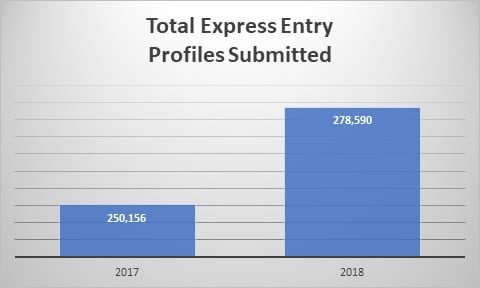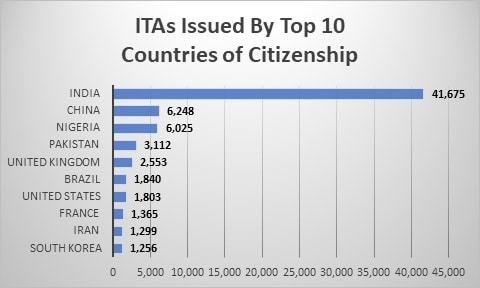Jul 4, 2019 – Canada’s immigration authorities received nearly 280,000 Express Entry profiles in 2018, making it the most popular year on record for the skilled immigration selection system.
The overall total of 278,590 received profiles represented a more than 10 per cent increase on 2017, as Canada immigration candidates flooded the system with expressions of interest.
Immigration, Refugees and Citizenship Canada released its Express Entry Year-End Report 2018 on Tuesday July 2, offering valuable insight into the inner workings of the world’s most cutting-edge economic immigration system.
Some of the 2018 Express Entry highlights include:
- Record 89,800 ITAs issued in 2018.
- Significant increase in number and percentage of eligible profiles.
- Major surge in number of profiles in Express Entry pool as of January 3.
- More than 40,000 ITAs went to candidates already in Canada.
- Domination of Express Entry ITAs by Federal Skilled Worker Program and Canada Experience Class.
- More than half of ITAs issued go to 20 to 29-year-olds.
- Nearly half of all ITAs issued to Indian citizens.
- 122,247 applications for permanent residence were sourced through Express Entry.

Increases in both the number and percentage of eligible profiles show how the calibre of candidate in the Express Entry pool is improving.
In 2018, 195,659 of the total profiles submitted, or 70 per cent were eligible for one of the programs covered by Express Entry, namely Canadian Experience Class, Federal Skilled Worker, Federal Skilled Trades and parts of the Provincial Nominee Program.
Those figures are up from nearly 162,500, or 65 per cent, in 2017.
This shows that under Canada’s economic immigration system, simply qualifying for the program does not guarantee a passage to permanent residence. Express Entry means candidates also have to record a sufficiently high score to secure a coveted Invitation to Apply (ITA).

Percentage of Eligible Express Entry Profiles


Although the Express Entry pool is dynamic, meaning it changes with every draw, the composition changes dramatically between 2017 and 2018.
Comparing the pools of January 3, 2018 to the same date in 2017, the 2018 pool shows a 33 per cent increase in the number of profiles.
Those increases are concentrated in profiles scoring 400-449 (+10,777 profiles) and those scoring 350-399 (+8,591).
This shows how competition has increased in profiles closer to the minimum Comprehensive Ranking System scores announced with each all-program draw.
During 2018, those minimum scores were concentrated in the 440-445 point range.
Express Entry Pool Composition on January 3
| 2017 | 2018 | |
| 400 – 449 | 20,404 | 31,181 |
| 350 – 399 | 28,983 | 37,574 |
| 300 – 349 | 17,385 | 21,110 |
| Total | 71,087 | 94,977 |
As has already been publicised, 2018 set a record for total ITAs, at 89,800. IRCC says the increase was in line with the increased high-skilled immigration target for 2018, a figure that is set to increase in each of the next three years.
When those invites are broken down by program, the dominance of the FSW and CES becomes clear, accounting for more than 78,000 of the total ITAs received.
The importance of program-specific draws in revealed by the breakdown, with just four FST candidates receiving invitations from all-program draws.
Two program-specific FST draws saw the other 900 invites issued through the program.

The IRCC report also reveals the importance of age in the Express Entry system.
More than half of the total ITAs issued in 2018 went to candidates in the 20-29 age bracket, while 85 per cent went to candidates aged between 20 and 34.
This sends a strong message that Canada is looking for young, well-educated people with knowledge of at least one of the official languages.

Furthermore, some 36,340 ITAs, or 41 per cent, went to candidates with Canadian work experience in 2018.
The important takeaway from this statistic is that coming to Canada on a work permit can be an excellent stepping stone to permanent residence.
This is backed up by another important figure, the more than 40,000 ITAs that went to candidates already in Canada during 2018.
The message is clear: that if your credentials do not allow you to come to Canada directly as a permanent resident, there is still a pathway available via the work permit route, if a qualifying job offer can be secured.
If you are a candidate looking for a Canada job, or an employer looking to recruit foreign talent from abroad, immigration.ca can help. Access our expertise through our in-house recruitment enterprises, www.skilledworker.com and our newest asset, www.skilledworker.com, “the leader in foreign recruitment”.

Meanwhile, the dominance of Indian citizens in the number of ITAs issued is also revealed in the report.
A substantial 41,675 ITAs went to Indian citizens in 2018, eclipsing second-place China by more than 35,000 invites.
India is now established as the most important source country for new economic immigrants to Canada. The number of Indians issued ITAs in 2018 is far more than the rest of the top 10 countries combined.

Given that Indians are renowned for their excellence in technology occupations, it should come as no surprise that the top 10 Express Entry occupations for 2018 are dominated by IT National Occupational Classification (NOC) codes.
The top three of software engineers, systems analysts and computer programmers are some of the most sought-after skilled workers in the Canadian economy.
That these three occupations rank so highly is evidence the Express Entry system is working, with nearly 15,000 invitations going to the most in-demand occupations.
Top 10 NOC Codes By ITAs Issued
| NOC | ITAs Issued | |
| 1 | 2173 Software engineers and designers | 6,126 |
| 2 | 2171 Information systems analysts and consultants | 5,429 |
| 3 | 2174 Computer programmers and interactive media developers | 3,450 |
| 4 | 1111 Financial auditors and accountants | 2,483 |
| 5 | 1241 Administrative assistants | 2,335 |
| 6 | 1123 Professional occupations in advertising, marketing and public relations | 2,049 |
| 7 | 4011 University professors and lecturers | 1,942 |
| 8 | 1112 Financial and investment analysts | 1,921 |
| 9 | 1122 Professional occupations in business management consulting | 1,915 |
| 10 | 0124 Advertising, marketing and public relations managers | 1,775 |
The IRCC report places significant importance on the number of ITAs going to candidates with additional points on their applications.
Since coming to power in 2015, the Liberal government has added additional points for Canadian education, French-language proficiency and for having a sibling in Canada.
The federal government also reduced the points available for a qualified job offer, while maintaining the 600 on offer for a provincial nomination.
More than half of the profiles receiving ITAs included one additional point type, with the most popular being the 15 or 30 points available for a Canadian education, featured in nearly 23,000 profiles.

IRCC received a total of 122,247 applications for permanent residence through Express Entry in 2018, including principal applicants and dependents.
Of those, 65 per cent or 78,383 indicated their intended destination as Ontario. This outlines the dominance Canada’s largest province, and in particular the city of Toronto, has on economic immigration.
The second highest-receiving province was British Columbia, with 22,153 application received.
It should be noted that Quebec is not included under Express Entry as the French-speaking province operates its own economic immigration system.

Despite the marked increases in numbers of ITAs and applications under Express Entry in 2018, IRCC still managed to maintain its target processing time of six months for 80 per cent of applications.
The average processing time across all programs in 2018 was five months, with only applications through the FST program averaging over the six-month target.
Processing times through FSW and CEC – which saw the vast majority of applications – were six months and five months respectively.
Express Entry Processing Time By Year and Program
| Express Entry Program | 2015 | 2016 | 2017 | 2018 |
| Canadian Experience Class | 3 | 6 | 4 | 5 |
| Federal Skilled Workers | 5 | 6 | 4 | 6 |
| Provincial/Territorial Nominees | 4 | 5 | 6 | 6 |
| Federal Skilled Trades | 5 | 6 | 6 | 7 |
| For all Programs | 4 | 6 | 5 | 5 |
* Processing times refer to the time in which 80 per cent of applications were finalized by IRCC
Conclusion
The IRCC’s Express Entry Year-End Report 2018 overs important insight into the inner workings of the economic immigration system.
It shows how the flexibility officials have to change the points system alters the profile of candidates who received ITAs through the system
With plans to increase immigration levels to 350,000 per year by 2021, the importance of Express Entry to Canada is only set to grow.
It has become an example to the world in how to operate a successful economic immigration system, attracting candidates who can be quickly integrated into Canadian society.
Interested employers: Kindly contact us here to receive further information.
Interested candidates: Find out whether you qualify to Canada by completing our free on-line evaluation. We will provide you with our evaluation within 1-2 business days.
Read more news about Canada Immigration by clicking here.





